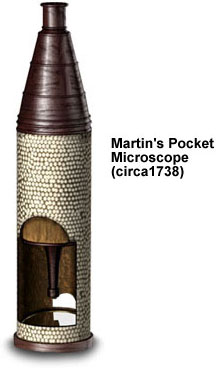Benjamin Martin's
Pocket Microscope
Benjamin Martin designed and built this microscope in the middle of the eighteenth century and named it the pocket microscope because of its small size and portability. This design became very popular and was later copied throughout Europe in several variations known collectively as the drum microscopes.

Basic construction of the pocket microscope consists of two tubes, the body tube housing two bi-convex lenses and the outer tube, which acts as a stand for the body tube. The outer tube is made of cardboard and covered with dyed rayskin, a popular choice of finishing material in the period. Focusing is accomplished by sliding the body tube up and down within the outer tube. The microscope is relatively small, being only about six inches tall with the draw tube fully extended. The outer tube has a large opening at the front of the base to allow the entry of light to illuminate the specimen by means of a large concave mirror fitted into the base. The specimens were mounted on a special slider, usually made from ivory or wood, that was placed into a small opening in the back of the microscope. In the many variations of this microscope, the body tube was made of either lignum vitae (a hard black wood), brass, or cardboard. The eyepiece used a bi-convex lens and the microscope was not fitted with a field lens. Several interchangeable low-power objectives were used with the microscope, which was one of the first to feature a built-in micrometer (a thin wire connected to a circular dial).
BACK TO EIGHTEENTH CENTURY MICROSCOPES
